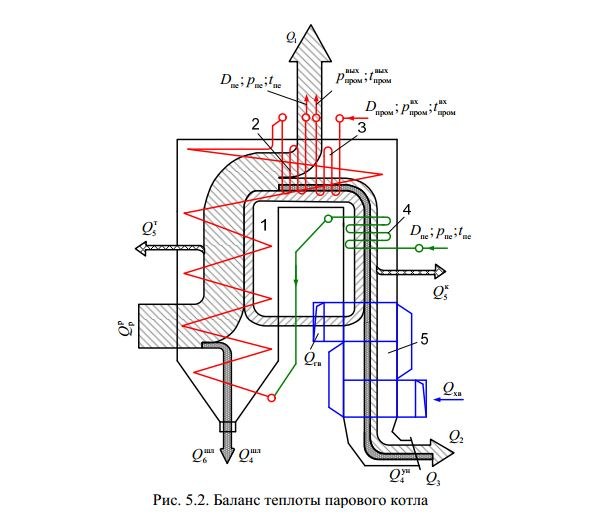The types of heat balance boiler
1. The direct equation of balance establishes dependence between fuel consumption and heat output of the boiler.
Definitely, the measured parameters and the amount of generated steam or water.
2. The equation of the inverse thermal balance establishes a relationship between boiler efficiency and heat losses (quantities expressed in percentage).
The heat balance prepared for the analysis of the processes occurring in the boiler furnace by the combustion of fuel, with the goal to identify the causes of performance degradation and; to develop the measures needed to improve efficiency.
The components of the heat balance
The heat balance of the boiler can be written as the equality Q = Q1 + Q2 + Q3 + Q4 + Q5, where Q is the total quantity of heat received by the furnace. It is the sum of the heat of combustion of the fuel, its physical heat and the heat received by the furnace with steam and fed to the combustion air: Q = q n + Qф.t + Qф.+ Qпар.
Q — oil- lower calorific value of the fuel, which is released by the complete combustion, excluding heat of condensation of water vapor.
Qф.t — physical heat of fuel is considered under the condition of preheating the fuel before feeding into the furnace.
Qф.in the heat of the air introduced into the furnace, is taken into account in the case when boiler is equipped with heaters.
Qпар — steam heat received by the furnace.
The right side of the equation represents the amount of heat used for steam generation or water (Q1) and heat losses (Q2 + Q3 + Q4 + Q5)
Q1 — the useful heat is spent on the production of steam or hot water.
Q2 — heat losses with exhaust gases (the most significant magnitude, reaching for modern boilers 4-10%. Their value depends on the type of fuel used, loading of aggregate, temperature and volume of flue gas, and significantly increases with the amount of air supplied for combustion).
Q3 — heat loss of chemical incomplete combustion of the fuel (increase when reducing the supply of air for combustion, in addition, depend on the type of fuel burned, the method of its combustion, furnace design and other factors).
Q4 — heat losses from physical incomplete combustion of the fuel (taken into account only when working with solid fuel).
Q5 — heat losses to the environment (depend on the quality and thickness of the covering of the boiler, from the conductivity of its material, from ambient air temperature, area, etc.). Are calculated by approximate formulas.
The heat balance is made in the established operation of the boiler, expressed in kJ/kg (kJ/m3) and usually refers to 1 m3 of gas or 1 kg of solid and liquid fuels, which at T = 0°C and P = 760 mm Hg. article (0.1 MPa).
The equation of the inverse balance
Is mainly used in testing boilers. Thus the calculated heat losses and the heat of combustion is determined by the gross efficiency of the boiler: FGP = 100 - (Q2 + Q3 + Q5).
Error in the determination of the heat loss is lower than when calculating the fuel consumption, therefore the method of determining the efficiency of reverse balance is more accurate.
